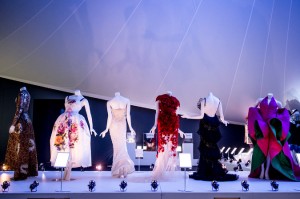



Apr
12
A cathedral-like structure soars overhead — in fitting grandeur to the gorgeous gowns below: Valentino’s black silk, Dolce & Gabbana’s Sicilian flowers, Capucci’s sweeping geometry in grass green and shocking pink.
But what is that rhythmic sound, penetrating the background music? It is the hum and click of a factory sewing machine.
“The Glamour of Italian Fashion: 1945–2014” at the Victoria & Albert Museum from Saturday to July 27 is a rare show that chronicles the birth of an industry and celebrates its beating technological heart.
It would have been easy for the curator, Sonnet Stanfill, to fill the museum’s rooms with splashy fashion from the 1980s and with today’s red carpet gowns. But she chose, instead, to measure Italian fashion as it moved from the ruins of the postwar period and the “sartoria,” or dressmaker wardrobes, to what is still — even after the invasion of Chinese factories into the heartland of Prato — the most effective industrial fashion machine in the world.
“Because this subject hasn’t been done, it offered us — the V&A — an opportunity to tell it in broad chronology, focusing on points of influence,” Ms. Stanfill said. “What we don’t have is a chronicle of Armani’s career or of Prada. It’s about key examples that help move the story along.”
Italian fashion history started in Florence, and the exhibition begins there with a photograph of ruined buildings after the Second World War. That morphs into displays of dresses against a background of twinkling chandeliers in the Sala Bianca, where couturiers, little known outside their Italian habitat, created dresses for contessas.
In Ms. Stanfill’s chronology, the kickoff point for Italian fashion was 1951, when the Florentine buying agent Giovanni Battista Giorgini opened up his home to American retailers like Bergdorf Goodman and I. Magnin, seducing them with a dolce vita of society balls and parties in his city’s Boboli gardens.
This was a period when the Parisian couturier Pierre Balmain sneered, “Let the Americans play around with baby bonnets in Italy — they’ll come to us for their serious buying.”
Yet Rome became a beacon for movie stars from the 1950s, and a striking section called “Hollywood on the Tiber” includes movies on giant screens, dresses worn by Ava Gardner or Audrey Hepburn and an image of Liz Taylor with glinting Bulgari emeralds.
The Italians had been smart enough to diversify from ball gowns to a postwar sporty glamour, represented in this exhibition by Irene Galitzine’s famous “palazzo pajamas” and Emilio Pucci’s beach and ski wear. A Pucci display has a mannequin in a patterned shirt and matching hose mounting a silvered green Vespa scooter, that symbol of youthful sexiness and postwar freedom.
Although Ms. Stanfill said that it was “quite daunting to concentrate on 70 years of fashion production,” the exhibition advances at a crisp pace — save a display of the dull wardrobe of a bourgeois wife.
The show embraces tailoring with verve, demonstrating that the differences between the seductive Neapolitan style and the elegant Milanese look are all about the sexual charge of the Alpha male. (John F. Kennedy chose a sensual suit from the Roman designer Angelo Litrico.)


